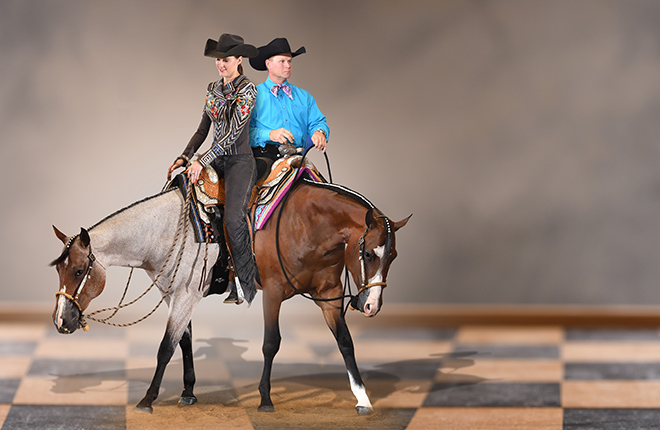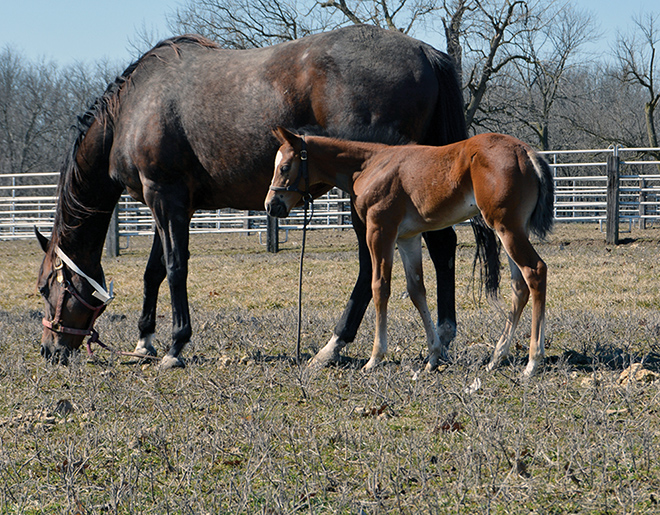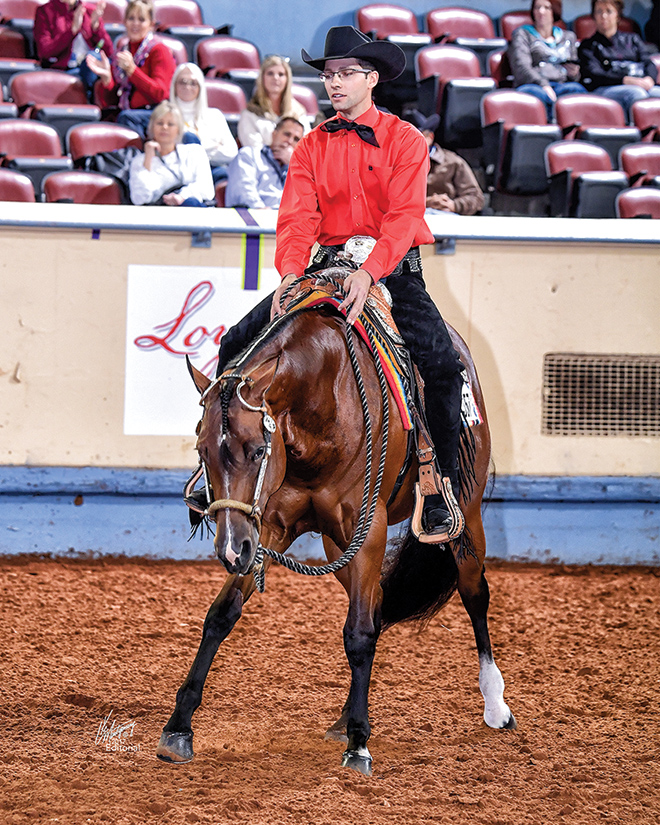They have the same genetic makeup. But it’s rarely the case that two foals sired by the same stallion and out of the same mare look, move or act exactly as each other, even when those foals are the result of multiple embryos from a single uterine flush.

Take flush mates What’s On Ur Mind and WhatGosAround for example.
Hillary Roberts bred her NSBA Hall of Fame mare Whatscookngoodlookin to multiple World and Congress Champion stallion VS Flatline in 2015. When she flushed Whatscookngoodlookin she got two embryos. Recipient mares carried the embryos to term and both resulting foals were born in 2016 and raised at her family’s Capital Quarter Horses facility in Pilot Point, Texas. Both were trained by Capital’s head trainer Andy Cochran.
But Hillary says that even though they both ended up with winning show records, they are really nothing alike and are distinct in their performance.
“What’s On Ur Mind (Pearl) is a bay roan mare. She is smaller and stouter than Tex (WhatGosAround), a huge bay gelding,” she said.

Roberts recalls that Pearl progressed a little quicker in training, is bomb-proof and has her dam’s signature jog. Tex was more of a late bloomer, is a little quirky with a tighter, slower jog and takes a little more time to get ready.
“They have a lot of similarities, but also plenty of differences when it comes to training,” she said. “They both broke out well and had the fire that their dam passes on.”
At the 2018 Quarter Horse Congress, WhatGoesAround won the Master 2-Year-Old Western Pleasure, with Cochran in the saddle. Hillary piloted What’s On Ur Mind to a win in the Open Division of the 2-Year-Old Non-Pro Western Pleasure. Both went on to have successful 3-year-old show careers.
“It was a lot of fun to watch flush mates each be really successful in the classes we put them in,” Hillary said.
This spring, at Richland Ranch in Auburn, Indiana, quadruplets were born as the result of crossing Brooke Granzow’s show mare, Darksyde Ofthemoon with John and Karen Boxell’s stallion, Mr Zippos Good Bar.


Karen Boxell, who manages all the stallions standing at Richland Ranch, said the first 2019 flush on Darksyde Ofthemoon produced one embryo. A subsequent flush resulted in three. All four went through the traditional embryo transfer process and were placed in recipient mares.
The resulting three fillies and one colt are nearly identical in color with good, correct structure, according to Boxell. At just a few months old, it’s anyone’s guess how similar the horses will perform, but Boxell says she has noticed slight personality differences.
“The filly that was born out of the flush that only had one embryo, has a mind of her own,” she said. “The other three just go with the norm.”
Boxell estimates having nearly 50 sets of twin embryos through the years. Not all survive implantation in the recipient mare, but she says the survival rate has been high.
“Some mares just tend to produce multiples each year,” she explained. “Darksyde Ofthemoon is one of those mares that tends to produce multiples.”
American Paint Horse Association trainer Sara Simons, of Pilot Point, Texas, says she has also seen that some mares are more likely to create multiple follicles. A successful gray thoroughbred mare show horse in the barn regularly delivers more than one follicle. However, tracking the offspring’s accomplishments is difficult because if the resulting foals don’t have enough color they can’t be registered and Simons sells them as 4-H and open prospects.
Thoroughbreds, warmbloods and draft horses have the highest chance of ovulating multiple follicles during any given cycle, according to a paper written by Patrick M. McCue DVM, PhD, Diplomate American College of Theriogenologists, Colorado State University Equine Reproduction Laboratory. In the same report, he says Quarter Horses have about a 10 % chance.
Unlike humans, horses can’t support multiples like triplets or quadruplets. Twins are even relatively uncommon in mares that carry their own baby. Veterinarians often recommend terminating one early in the process because of significant risk to the foals and mother. In some cases, twins survive but nearly 80% of twin pregnancies abort on their own.
With the increased use of embryo flushing and recipient mares, the arrival of “twin” foals poses no risk to their dam. But just because these horses are genetically similar doesn’t guarantee both will look, act or perform the same. Simons witnessed this with a 2016 mare and gelding pair out of a Zippos Sensation and Behind Blue Eyes cross. The mare, Sensational Addiction, was about three inches shorter and excelled in western events, especially trail, where her sibling was built more like a thoroughbred and specialized in hunter events.
“They were both good minded like the mare,” Simons said. “Each horse is pretty unique, and I don’t think we can put a lot of stock in the fact that they’re twins.”
So how similar or different are these horses? We asked breeders, trainers and exhibitors about their experiences with flush mates and full siblings born in different years.
Here’s what they had to say.
Flush mates
Identical human twins are physically indistinguishable. Since they share the same DNA, they often display similar personality traits and talents. Horse owners tend to assume the same traits of human twins apply to horse doubles.
“Our ideas and perceptions of twins in humans is gravely different than what occurs in horses,” Simons said.
Jenna Dempze’s AQHA mare Black And Elegant produced two foals by Machine Made in 2012. At first glance, they could be compared to identical human twins. Both were bay with white stars. The only distinguishing feature was a white leg marking, each had one, but not on the same leg.
Jenna sold Minutte Made through the NSBA sale as a yearling. She kept the other, Made Rite, until the spring of its 2-year-old year. Both became show horses with one taking to Trail and the other as a novice youth all-around horse.
“I didn’t really have enough time with them to know if they were similar minded but the little I did get to know them, they reminded me more of the stud than the mare,” she said.

Halle Saywell Baldwin, of Boerne, Texas, bred her AQHA show mare, A Gift So Good, to Willy Be Invited in 2006. The mare double ovulated and two embryos were flushed. The following year a sorrel colt was born, which Halle named Willys So Good. He was eventually gelded and went on to earn countless AQHA points in all- around classes. Leeman Farms in Massillion, Ohio kept the other resulting foal but unfortunately that one died at one day old.
A year later, Baldwin bred A Gift So Good to One Hot Krymsun and again flushed two embryos, resulting in two foals born the following year – A Krymsun Gift (name later changed) and So Good To Be Hot (Lucy). The foals out of A Gift So Good crossed on One Hot Krymsun looked alike, both with white blazes and one white leg marking each, but Baldwin recalls their temperaments were dramatically different. One was sweet, the other naughty. The Baldwins sold Lucy before competing on the mare, but she went on to earn 124 open and amateur points, while her flush mate was more suited to the open show circuit.
“There is no guarantee that you’re going to get the same horse,” she said.
Treat them like individuals
Each cross is a breeder’s best educated guess as to what blend of genetics will result in a talented horse that can win in the show pen. No matter how well-bred a horse is, they just may not work out. Conversely, one that’s not as well-heeled may surprise you and rise to the top. Raising or buying full siblings may tip the scales in your favor because the genetics are proven, but Texas trainer Aaron Moses encourages clients not to bank on it.

“The full siblings I’ve had are not as similar as you would think they would be,” he said. “We’ve had full siblings and seen full siblings to horses that we’ve had that don’t look alike and a lot of them don’t move alike. They can be very different in every way.”
Drew DeBuhr agrees that breeding or buying full siblings doesn’t mean you’re getting a carbon copy of a winning horse. He thinks the chances are better when the mare is great producer of full siblings, but he still treats each as an individual.
He points to Onlythebestforyou and Only The Best Chips, full siblings sired by RL Best of Sudden and out of Only Classic Chips.
Only The Best Chips, a 2015 bay mare, was more petite than her younger brother, Onlythebestforyou, foaled in 2016.
She had a successful Western Pleasure show career, placing in the top five of the of the 2-Year-Old Intermediate Open Western Pleasure at the 2017 NSBA World Show. Onlythebestforyou, a gelding, was much larger and claimed a Reserve Congress Championship in the Limited Division of the 2-Year-Old Non-Pro Hunter Under Saddle in 2018.
“The trainers you are working with have the best chances of being able to tell if they have similar good qualities,” he said.
Drew is currently training Makin Martinis, a full sibling to Mamma Made Martinis, a horse his brother, Denton, showed to a Congress Championship in the 2-Year-Old Limited Open Western Pleasure Stakes class last year.
Drew said these full-siblings are more similar in temperament than the RL siblings, but look nothing alike. The 3-year-old is a red roan mare and the 2-year-old a sorrel colt.
“Even if they don’t look anything alike, but are conformationally correct then your chances are better,” he said.
Moses encourages riders to think of each horse as an individual and remain open minded when considering full siblings. For example, one might win a lot in western pleasure, but its full sibling is a top all-around horse.
“Don’t try to fit into a mold just because a family member did something in one event,” he said. “They may be equally great just at different things and you can’t force any horse into something it’s not able to physically do.”
Staying the course or mixing it up
Raising babies is a gamble and many factors go into making a great one. From the parents to the owners and the trainers, who all play a role developing one into a show horse and a lot of changes occur from the time a foal is born to when it is started under saddle.

“We’ve seen some of the same qualities and definitely liked what we saw in foals out of A Gifted Invitation by Lazy Loper and VS Code Red and that’s why we’ve bred back to them,” Baldwin said.
Roberts likes to use a mix of repeating the same cross while also trying new pairings. Being open to both options gives her flexibility to experiment each breeding season while also using what she knows works for her program.
“I think if it works and you like the product of the cross, do it,” she said. “If it’s not broke, don’t fix it. We like to mix it up and try new things, see what other crosses may work, but it’s nice to know that there’s a cross that has a great track record to go back to.”

Dempze, who has had the opportunity to own and show several sets of full siblings, says she is not convinced that genetics alone necessarily improves your chances for like offspring. In 2012, she rode Gotta Certain Touch, a 2010 gelding sired by Certain Potential and out of Gotta Touch This, to her first Tom Powers 2-Year-Old Non-Pro Western Pleasure Championship. When Gotta Touch This was bred back to Certain Potential in 2012 the resulting foal was She Don’t Be Certain, a bay filly.
“Gotta Touch This was the easiest baby I ever had,” Dempze said. “He was easy to train and had a lot of natural ability. On the other hand, everything with the filly was a struggle and she was really strong-minded.”
Jenna also purchased full siblings, Rewind And Repeat and his full sister, Reissued In Red, both sired by Repeated In Red and out of Sweet On Occasion. Rewind And Repeat, a bay gelding, was a Congress and AQHA World Champion with an extensive show career. His little sister, a sorrel filly, also amassed quite an impressive show record. But Dempze said that in addition to their appearance, they were very different.
Based on her experiences, she isn’t convinced striving for full siblings is always the best option. She said she feels that if one good horse is produced from a specific cross, then the chances of getting another great one from the same combination are smaller.
“A lot of those great horses are just freaks,” Jenna explained. “Their movement, their mind, so many things have to come together to make them great, including all the people involved. There are so many different factors that play into it.”


You must be logged in to post a comment Login